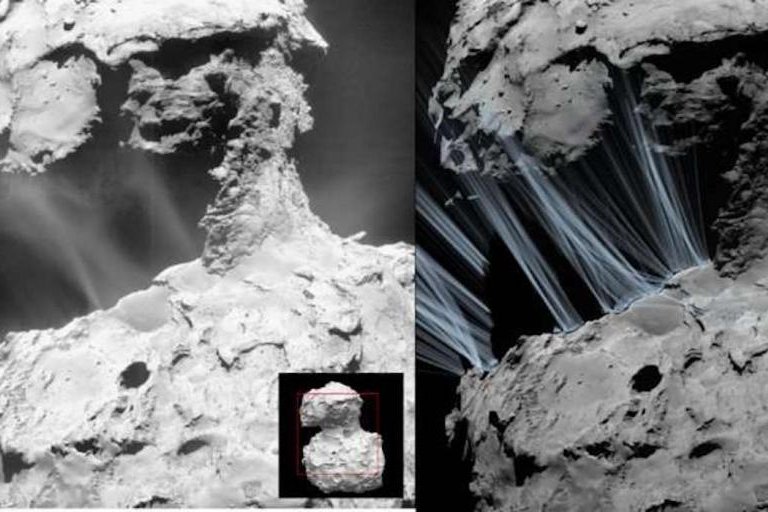Comet 67P's peanut-like shape and pitted texture causes gas and dust to become concentrated and triggers the formation of sunrise jets. Photo by ESA/Rosetta/MPS
May 23 (UPI) -- Thanks to data collected by the Rosetta probe, astronomers are beginning to understand the factors responsible for the formation of sunrise jets, which are unique dust and gas jets emitted by comets.
Sunrise jets are narrow strands of gas and dust extending from a comet's surface. They spring to life when a comet moves into the inner solar system and become bathed in sunlight, causing ice to melt and water vapor to envelope the orb.
Using data collected by the European Space Agency's Rosetta spacecraft, which orbited and observed comet 67P/Churyumov-Gerasimenko from August 2014 to September 2016, astronomers were able to catalogue the comet's gas and dust emissions.
The more than 70,000 images captured by Rosetta's scientific camera system OSIRIS revealed both sudden eruptions of gas and dust, as well as more stable, prolonged jet-like emissions.
New analysis of Rosetta's data -- published in the journal Nature Astronomy -- revealed a regular uptick in emissions activity every morning.
"When the sun rises over a part of the comet, the surface along the terminator almost instantaneously becomes active," Xian Shi, a researcher from the Max Planck Institute for Solar System Research, said in a news release. "The jets of gas and dust, which we then observe within the coma, are very reliable: they are found each morning in the same places and in a similar form."
Researchers suggest frost is responsible for the morning routine. Each night, tiny droplets of ice crystalize on the comet's surface, and each morning, they're quickly vaporized.
"Outbursts can often be traced back to a small area on the surface where suddenly frozen water is exposed, for example due to a landslide," said Holger Sierks, MPS researcher and principal investigator for OSIRIS. "In the case of cometary activity at sunrise, this is different. The frost is distributed fairly evenly over the entire surface."
Given the even distribution, astronomers were interested in understanding why individual jets form instead of a diffuse cloud of gas and dust. The latest analysis suggests the comet's shape and texture are key.
The comet's bi-lobed, peanut-like shape causes some portions of its surface to be hit more directly by the sun's energy, while the surface's pitted texture and concave structures caused gas and dust to become focused, just as light is concentrated by a concave lens.















